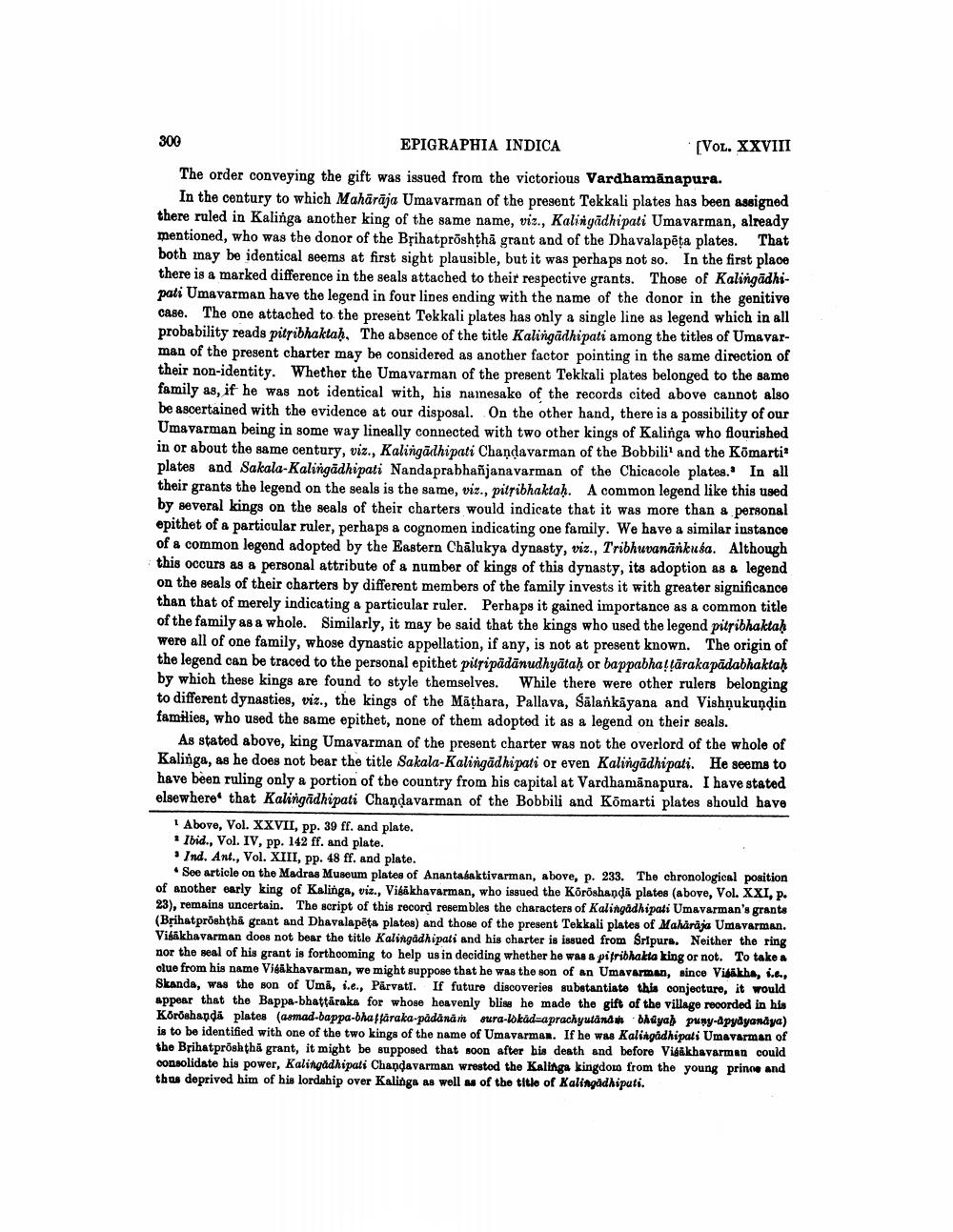________________
300 EPIGRAPHIA INDICA
[VOL. XXVIII The order conveying the gift was issued from the victorious Vardhamānapura.
In the century to which Mahārāja Umavarman of the present Tekkali plates has been assigned there ruled in Kalinga another king of the same name, viz., Kalingādhipati Umavarman, already mentioned, who was the donor of the Brihatproshtha grant and of the Dhavalapēta plates. That both may be identical seems at first sight plausible, but it was perhaps not so. In the first place there is a marked difference in the seals attached to their respective grants. Those of Kalingādhipati Umavarman have the legend in four lines ending with the name of the donor in the genitive case. The one attached to the present Tekkali plates has only a single line as legend which in all probability reads pitribhaktah, The absence of the title Kalingadhi pati among the titles of Umavarman of the present charter may be considered as another factor pointing in the same direction of their non-identity. Whether the Umavarman of the present Tekkali plates belonged to the same family as, if he was not identical with, his namesake of the records cited above cannot also be ascertained with the evidence at our disposal. On the other hand, there is a possibility of our Umavarman being in some way lineally connected with two other kings of Kalinga who flourished in or about the same century, viz., Kalingăthipati Chandavarman of the Bobbili' and the Kōmarti plates and Sakala-Kalingadhipati Nandaprabhañjanavarman of the Chicacole plates. In all their grants the legend on the seals is the same, viz., pitfibhaktaḥ. A common legend like this used by several kings on the seals of their charters would indicate that it was more than a personal epithet of a particular ruler, perhaps a cognomen indicating one family. We have a similar instance of a common legend adopted by the Eastern Chalukya dynasty, viz., Tribhuvanānkusa. Although this occurs as a personal attribute of a number of kings of this dynasty, its adoption as a legend on the seals of their charters by different members of the family invests it with greater significance than that of merely indicating a particular ruler. Perhaps it gained importance as a common title of the family as a whole. Similarly, it may be said that the kings who used the legend pitsibhaktah were all of one family, whose dynastic appellation, if any, is not at present known. The origin of the legend can be traced to the personal epithet pitsipādānudhyātaḥ or bappabhaltārakapādabhaktaḥ by which these kings are found to style themselves. While there were other rulers belonging to different dynasties, viz., the kings of the Māthara, Pallava, Salankäyana and Vishņukundin families, who used the same epithet, none of them adopted it as a legend on their seals.
As stated above, king Umavarman of the present charter was not the overlord of the whole of Kalinga, as he does not bear the title Sakala-Kalingādhipati or even Kalingadhipati. He seems to have been ruling only a portion of the country from his capital at Vardhamanapura. I have stated elsewhere that Kalingadhipati Chandavarman of the Bobbili and Kömarti plates should have
Above, Vol. XXVII, pp. 39 ff. and plate.
Ibid., Vol. IV, pp. 142 ff. and plate. • Ind. Ant., Vol. XIII, pp. 48 ff. and plate.
. See article on the Madras Museum plates of Anantasaktivarman, above, p. 233. The chronological position of another early king of Kalinga, viz., Visakhavarman, who issued the Köröshanda plates (above, Vol. XXI, p. 23), remains uncertain. The script of this record resembles the characters of Kalingadhipati Umavarman's grants (Brihatproshthi grant and Dhavalapēta plates) and those of the present Tekkali plates of Maharaja Umavarman. Visakhavarman does not bear the title Kalingadhipati and his charter is issued from Sripurs. Neither the ring nor the seal of his grant is forthooming to help us in deciding whether he was & pifribhakta king or not. To tako olue from his name Visakhavarman, we might suppose that he was the son of an Umavarman, since Visakha, i..., Skanda, was the son of Uma, i.e., Parvati. If future discoveries substantiate this conjecture, it would appear that the Bappa-bhattaraka for whose heavenly blise he made the gift of the village recorded in his Köröshapdā plates (asmad-bappa-bhaffäraka-padanam sura-lokád-aprachyutandu bh@yah puny-apydyanaya) is to be identified with one of the two kings of the name of Umavarman. If he was Kalingadhipati Umavarman of the Brihatproshtha grant, it might be supposed that soon after his death and before Visakhavarman could consolidate his power, Kalingadhipati Chandavarman wrestod the Kalinga kingdom from the young prince and thus deprived him of his lordahip over Kalinga as well as of the title of Kalingadhipuli.




